Current Research Projects
Research of the Center for Integration of Composites into Infrastructure (CICI)
Engineering Design of the Warstone Innovations SCS System
Rudi Seracino and Gregory Lucier
Abstract:
Current repair and strengthening methods of timber poles and piles are time consuming and in need of advancement. Timber poles and piles often experience damage through natural disasters or accidents and incur rot due to a variety of factors including environmental conditions, fungal decay, and marine borers, which can all lead to a significant reduction in the effective timber structural integrity. Loading requirements may have also changed since the original design and installation, creating a functionally obsolete support structure. Various techniques have been used to repair and strengthen damaged timber piles and poles. Common repair methods include the use of composite materials in the form of a fabric wrap or GFRP jackets filled with a grout to encapsulate the damaged timber. The purpose of this project is to analyze and test a newly developed repair and strengthening jacket system that incorporates preinstalled internal CFRP straps with a conventional GFRP shell. The internal CFRP straps are joined with an innovative Continuity Connection that enables ease and speed of construction while ensuring full confinement provided by the CFRP straps, offering a new and efficient repair and strengthening method for timber poles and piles. Laboratory tests are underway to determine optimal design and capacities for this proprietary SCS System.
Structural Behavior of Grancrete Material
Fabricio Montesdeoca and Sami Rizkalla
Grancrete
Abstract:
The research program is designed to examine a new type of concrete as material for construction of buildings, bridges and special infrastructural applications. The initial phase of the evaluation includes tests to determine the basic material characteristics of Grancrete including compressive strength, elastic modulus, tensile strength, creep, shrinkage, and toughness of materials. The second phase will include examining the behavior of Grancrete mixed with small aggregate to enhance the overall behavior as construction materials. Based on the findings, the research will be extended to include the behavior of Grancrete reinforced with steel reinforcements and fiber reinforced polymer materials. The research plan will be examined every six months with the industrial members to finalize the research needed to optimize the use of these materials as construction material.
Development of Rational Design Methodology for Precast, Prestressed Concrete Spandrel Beams
Gregory Lucier, Catrina Walter and Sami Rizkalla
Precast/Prestressed Concrete Institute (PCI)
Abstract:
The goal of the proposed research is to develop appropriate design procedures and to simplify the detailing requirements for precast, L-shaped spandrel beams. The research includes an extensive experimental program designed to test prototype precast L shaped spandrel beams and an analytical phase based on non-linear finite element techniques.
Shear Behavior of MMFX Stirrups
Matthew Sumpter and Sami Rizkalla
MMFX Technologies Corporation
Abstract:
The objective of this test program is to determine the feasibility of using MMFX reinforcing bars as shear reinforcement for reinforced concrete structures. To achieve this objective, comparative tests will be conducted for shear critical reinforced concrete beams using both conventional steel and MMFX steel reinforcements. The experimental program consists of nine reinforced concrete beams of each series are further divided into 3 groups of 3 beams each. Within each group, the variable would be the amount of shear reinforcement – the minimum, the intermediate, and the maximum amounts.
Evaluation of Bond Characteristics of MMFX Steel
Hatem Seliem and Sami Rizkalla
MMFX Technologies Corporation
Abstract:
The high-strength steel commercially known as Micro-composite Multi-structural formable (MMFX) steel could lead to potential savings through the use of lower reinforcement ratios due to it’s higher strength. The proposed research will investigate the bond behavior of MMFX steel to concrete. The first phase of the proposed research program will include the parameters believed to significantly affect the bond strength: concrete compressive strength, bar size, concrete clear cover, and confinement level. Three universities are participating in this study, namely, University of Texas at Austin, The University of Kansas, and North Carolina State University. Each university will test twenty-two full-scale splice beams for the first phase of the program.
Bond Characteristics And Qualifications Of Adhesives For Marine Applications And Steel Pipe Repair
Glen Smith, JD Vickery, Engin Murat Reis, Tarek Hassan, and Sami Rizkalla
IPS
Abstract:
Significance of the Proposed Work:
Industrial adhesives have become an important component of the structural elements with the developing technology of new materials. Adhesives that bond metals, plastics, FRP and other materials have been used in transportation, industrial and marine applications. Fundamental understanding of the bond behavior and load transfer mechanisms of different adhesives is essential prior to their use in civil infrastructure. The proposed research introduces a new industrial adhesive. It is intended to investigate the bond properties of the adhesive which will be used in the design of structures.
Objectives and Scope of Work:
The main objective of this research is to evaluate the engineering properties of the new adhesive, which is referred to as adhesive “S”. Mainly, the bond characteristics between composite-to-composite and composite-to-steel materials will be investigated. As a control product, an adhesive currently in use, referred to as adhesive “M”, will be used and tested using the same testing scheme as that for adhesive “S”. A comprehensive experimental program will be designed using single lap-joint specimens. The setup for Single Lap-Shear test is shown in Figure 1.The influence of high temperature and creep on the bond characteristics will be examined. Strength properties in cleavage peel by tension loading will be determined.
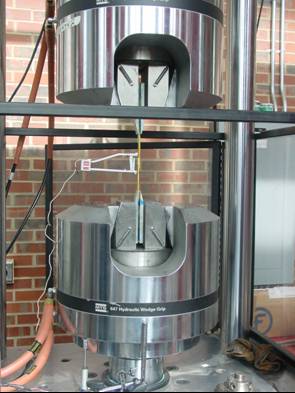
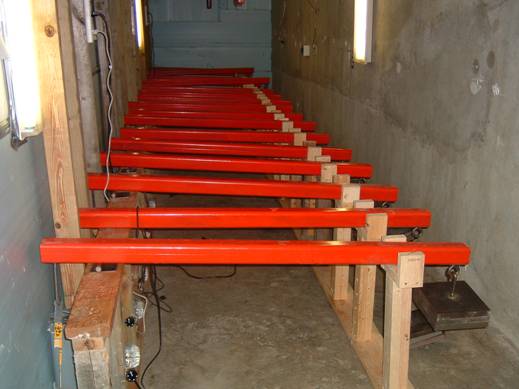
Research Plan:
The proposed research includes mainly four experimental phases. The first phase consists of lap shear tests to determine the bond characteristics of two adhesives used between two Glass Fiber Reinforced Polymer (GFRP) sheets. The work will be extended to examine the behavior between GFRP and steel surfaces. At the current stage a total of ten composite-to-composite lap shear specimen have been tested. The failure modes will be examined in order to determine which is most appropriate for the typical application.
The research also includes durability study. The test will consist of a total of 76 specimens submerged in de-ionized water with different PH values and different temperatures. A specially designed insulated room has been constructed to house the instrumentations which were built to subject the specimens to the specified environments (Figure 2).
Also Cleavage Peel tests for composite-composite and steel-composite specimens will be conducted according to ASTM 3807 98. The testing will be performed at room temperature. The last phase of the experimental program consists of lap shear specimens loaded to 400, 600 and 1000 psi for creep testing.
Impact to the State of Practice:
In general, findings of this research program will enable engineers to make more informed decisions regarding the use of adhesives in different structural applications. Design guidelines, as well as the bond characteristics of different adhesives under severe environmental conditions, will be provided.
Innovative 3-D Frp Sandwich Panels For Transportation & Infrastructure
Engin Murat Reis , Tarek Hassan, and Sami Rizkalla
Martin Marietta Composites
Abstract:
Significance of the Proposed Work:
Continuous development of FRP materials in various forms and configurations using affordable fabrication techniques offers an alternative design approach for structural elements and present new challenges to researchers and engineers. In the past few years, various FRP composite panels have been implemented in highway and pedestrian bridge construction. Light-weight, excellent corrosion characteristics and rapid installation capabilities created tremendous opportunities for FRP composite panels in transportation industry. World wide, there are many completed or currently underway applications using FRP composite panels in civil infrastructure. Nevertheless, proper characterization methods and generally accepted design and analysis procedures for FRP composite panels have not been established. Technical difficulties during fabrication, lack of comprehensive analysis and design guidelines limit the full utilization of these materials. The proposed research introduces new generation of FRP composite panels produced by Martin Marietta Composites, USA. The research aims to develop a general structural analysis methodology for FRP sandwich panels. Structural behavior, strength and stiffness characteristics of various FRP panels will be investigated both experimentally and analytically. Design guidelines for the use of FRP sandwich panels in transportation Infrastructure will be provided.
Objectives and Scope of Work:
The primary objective of the proposed research is to study and examine the structural performance of innovative FRP sandwich panels produced by Martin Marietta Composites, USA. The panels consist of top and bottom skin GFRP layers connected together using through-thickness fibers (Z-tows). Failure modes and mechanisms will be investigated through a comprehensive experimental program. Stiffness and strength analysis methodologies will be established and complete set of design guidelines will be provided. The test setup for various FRP panels under different loading conditions is shown in Figures 1, 2 and 3.
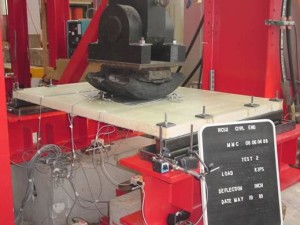
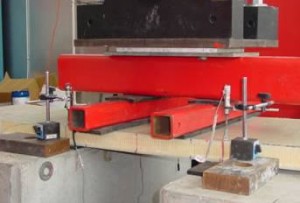
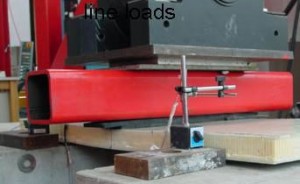
Research Plan:
The experimental program includes two phases. Fundamental material properties in tension, compression and shear will be evaluated in the first phase of the experimental program. The second phase will focus on the overall panel behavior under various loading conditions. The analytical phase will attempt to propose a ply-level analysis philosophy and will provide general procedures for strength and failure analysis of FRP sandwich panels. The flexural, one-way and two-way shear behavior of FRP sandwich panels will be investigated. The main variables in this study will include the thickness of the panel, number of GFRP plies in the top and bottom skin layers, intensity of vertical pins and type of loading. The behavior of the panels during testing will be monitored using a combination of electrical strain gauges, string potentiometers and PI gauges.
Impact to the State of Practice:
The proposed study will provide a significant contribution to the current knowledge with regard to the behavior and analysis procedures for FRP sandwich panels. Findings of the research will assist in developing reliable design procedures for the practical use of FRP composite sandwich panels in numerous structural applications under different loading conditions.
Retrofit of Steel Structures using Fiber Reinforced Polymers (FRP): State-of-the-Art
Amr Shaat, David Schnerch, Amir Fam and Sami Rizkalla
Abstract:
This paper describes the research progress to date in the field of strengthening and repair of steel structures using fiber reinforced polymers (FRP). While this subject has been extensively covered for concrete structures, there has been limited research work related to FRP applications in strengthening of steel structures. This paper provides review of research work on retrofit of steel flexure members including repair of naturally corroded beams, repair of artificially notched beams, strengthening of intact beams, and strengthening of steel/concrete composite flexure members as well as the retrofit efforts of thin-walled tubular sections. The paper also reviews the fatigue behavior of such technique. Bond and force transfer mechanisms are discussed. A field application is presented. Research needs in this field are also discussed.
Use of High Modulus Carbon Fiber Reinforced Polymers (CFRP) for Strengthening Steel Structures
David Schnerch, Kirk Stanford, Bryan Lanier, Mina Dawood, Emmett Sumner, and Sami Rizkalla
Mitsubishi Chemical FP America, Inc.
Abstract:
Cost-effective solutions for the rehabilitation and strengthening of steel structures, such as steel bridges and steel monopole towers used for cellular phone antennas, are greatly needed by government transportation departments and industry. Rehabilitation is often required due to loss of cross-section due to corrosion and/or changes of the demand or use of a structure. Current techniques for strengthening steel structures have several drawbacks including requiring heavy equipment for installation, their fatigue performance in addition to the need for ongoing maintenance due to continued corrosion attack. The current research program proposed the use of a new high modulus carbon fiber reinforced polymer (CFRP) for strengthening of steel structures. This program, currently in progress, includes extensive research to select the resin for wet lay-up of carbon fiber sheets and the adhesives for bonding of pre-cured laminate strips. Test results of the first scaled monopole tower, tested at the Constructed Facilities Laboratory at North Carolina State University, showed a 25% increase in stiffness in the elastic range over the same monopole before strengthening. This paper summarizes also the remaining program, including the strengthening of other monopoles and a steel-concrete composite girder to be strengthened using different techniques. Experimental results for these tests will be reported at the workshop presentation.
Strengthening Steel Structures and Bridges with High Modulus Carbon Fiber Reinforced Polymers: Resin Selection and Scaled Monopole Behavior
David Schnerch, Kirk Stanford, Emmett A. Sumner, and Sami Rizkalla
Mitsubishi Chemical FP America
Abstract:
Cost-effective solutions for the rehabilitation and strengthening of steel structures, including bridges and monopole towers, are greatly needed. Rehabilitation is often required due to cross-section losses occurring due to corrosion and strengthening may also be required due to changes in the use of a structure. Current techniques for strengthening steel structures have several drawbacks including their fatigue performance and the need for ongoing maintenance due to continued corrosion attack. The current research program makes use of a high modulus carbon fiber for strengthening of steel structures. This program, currently in progress, includes phases for the resin and adhesive selection for wet lay-up of carbon fiber sheets and bonding of pre-cured laminate plates. Test results of the first scaled monopole tower showed a 25% increase in stiffness in the elastic range over the same monopole before strengthening.
Strengthening In-fill Brick Walls with Composite
Sami Rizkalla
E. Fyfe Company
Abstract:
Proposed Testing Program for Validation of Compliance of EPS-LWC to Shear and Bond Provisions of ACI 318-08 Building Code Concrete
Sami Rizkalla
NSF – I/UCRC – RB2C – Nova Chemicals
Abstract:
The research program is designed to evaluate the compliance to the shear and bond provisions of the ACI 318-08 Building Code for reduced weight concrete using expanded polystyrene spheres produced by Nova Chemicals. The proposed experimental program will be conducted in two phases. The first phase focuses on evaluating the shear behavior of beams produced by the reduced unit weight concrete with polystyrene spheres. The second phase focuses on evaluating the development length of the steel reinforcement for concrete with polystyrene spheres.